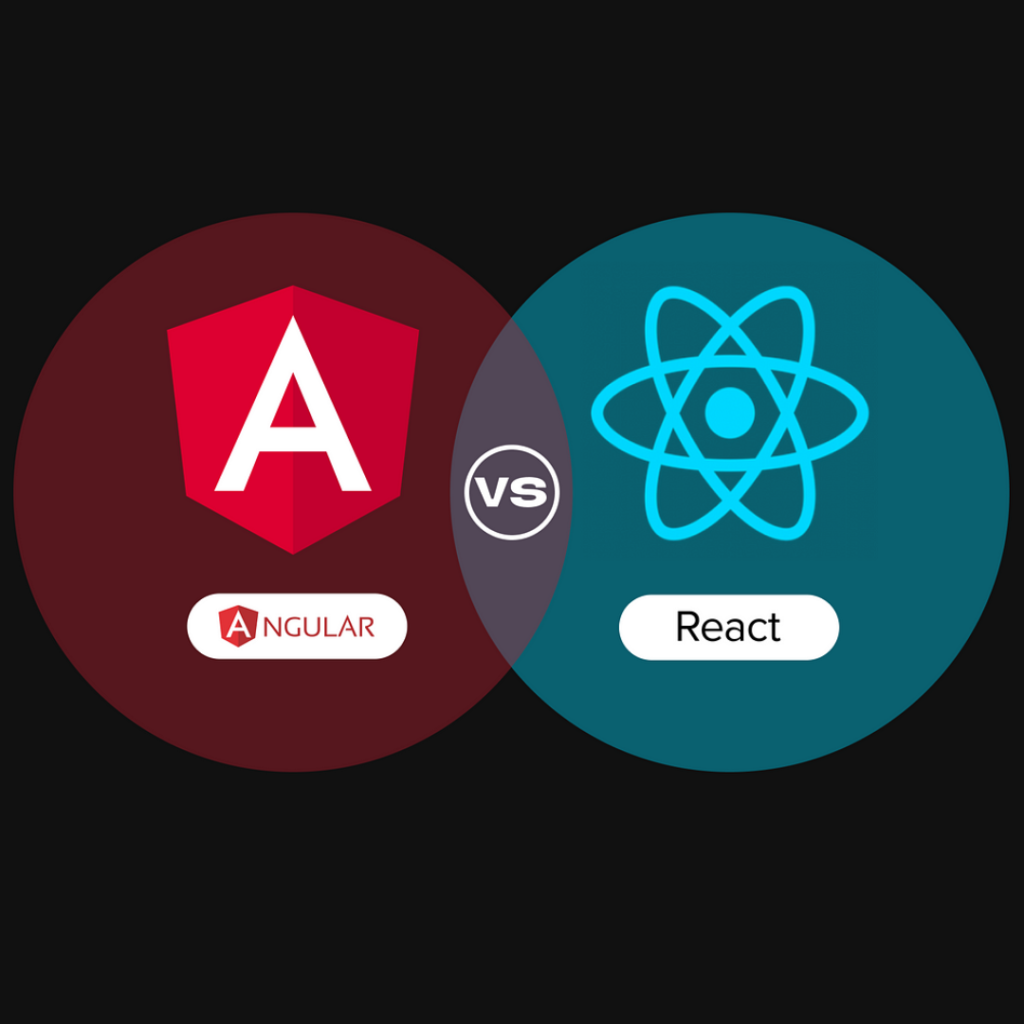User experience surfaces topmost and is of great importance in every web application development process. Regardless of how multifaceted operations and functions occur in the background, the user views and experiences must be high quality. As a developer, you can achieve this through front-end development frameworks.
A front-end development framework is a platform for transforming data into a graphical interface through JavaScript, CSS and HTML to enable users to observe, interact and network with that data. Front-end frameworks embrace ways to construct your files, relate data with Document Object Model elements, style your components and make AJAX requests.
You’ll find Angular and React, the most popular frameworks for front-end programming when you explore the JavaScript ecosystem. But, when should you use Angular over React, and why or when should you use react over Angular, and why? For years, there have been significant differences between these distinguished frameworks. Let’s explore the two!
ANGULAR
Angular is a structural development platform based on the built-in typescript. It’s a component-based framework for developing web applications. Angular was built and is maintained by the tech giant GOOGLE. Angular allows developers to use HTML as a template language and allows HTML syntax to reveal the application’s elements briefly and clearly.
Angular possesses features and well-integrated libraries such as routing, client-server communication, and command-line interface. This framework supports the Model View Controller programming structure that argues the conformability of browser-based applications by lowering the JavaScript code required to keep the application valuable and robust. It has a Cross-Platform where you can design and build progressive web applications. Still, Angular possesses a suite of developer tools to develop and scale projects from single developer size to enterprise-grade applications.
Angular is popular because of its two-way data binding trait. With two-way data binding, there is real-time synchronisation between view and model, where any adjustment in the model recreates swiftly.

Why Use Angular
Angular is considered a self-sustained solution for developing the fastest data-driven web application. Here are some reasons for choosing angular.
- Unlike other frameworks, Angular provides automatic synchronisation with two-way data binding. It effortlessly synchronises the data between View and Model. Therefore, these two elements are automatically updated in real-time when the data is redesigned. Without the two-way data binding feature, you and your development team would manually make changes, wasting time and extra effort.
- Angular brings forth fundamental features such as the Command-Line Interface and RXJS, robust enough to create channels for data exchange and independent control of events. Designing apps, adding files and debugging projects are not confusing when using Angular.
- The Angular framework leverages HTML, a less composite language compared to JavaScript. HTML is a declarative user interface and in-built language that terminates planning for what loads first and what program flows. So, you’ll have to plan what is needed, and the framework will do the rest.

When to Use Angular
Angular possesses many well-integrated features that help you work on various projects. Here are some of the situations in which you can use Angular.
- In case you want to add static type to your code. Angular is the ideal framework, unlike JavaScript, which only supports dynamic types. Since codes in Angular are written using TypeScript, it allows you to add your static type to the code. Static typing helps you recognise bugs earlier and faster during the development process. With TypeScript, you have a codebase that is rectifiable and predictable.
- Say you want to simplify your development process by automating crucial processes like configuration and app initialisation, Angular is the best option you have. With the help of its Command-Line Interface feature, you can attach elements to your angular application. And also, Angular CLI enables you to perform end-to-end testing for independent components and the entire software at large.
- Angular is the perfect framework to use when developing an extensive-scale application. Angular has a cohesive component-based architecture, and its components are referred to as foundational blocks. Components in Angular are self-sufficient and reusable. While developing your large-scale application, you’re obligated to utilise similar functionalities across the different parts of the application. A component designed with a single functionality can be reused to change the details of the components if necessary. Besides reusability, components in Angular are easily maintainable. This implies that parts can be replaced with the wanted implementations when the app requires changes and new features.
Why Use Angular over React
- Angular is a framework, not a library, unlike React, a JavaScript library for developing user interfaces. Angular is a framework consisting of all the features required to build an application. Features like two-way data binding help display information to the end user and permit the end user to adjust to the UI’s underlying data. Therefore, Angular offers you more out-of-the-box and is more dictatorial on the structure of your app.
- Unlike React, Angular uses two-way data binding that gives components in the application an approach to sharing data. Two-way data binding helps end-users communicate in multiple directions and ensures that data is always synced at all levels.
- Angular offers increased consistency for standard components. Unlike React, most features like testing, view routing and HTTP requests are in-built. This implies that these components will be improved and supported as long as Angular is alive. For instance, when using react, you must select an HTTP library; if you make a mistake, this library will be abandoned. A new library must be used, which calls for careful rewrites and new potential bugs.
REACT
React is an open-source front-end JavaScript library for developing reusable user interfaces based on UI components for single-page applications. React was built and is supported by Facebook; it handles the view layer for mobile and web applications. React can be used with other frameworks, such as Angular, to build large web applications that change data without reloading the page.
React has declarative features such as JSX or React Native, enabling you to build complex user interfaces effortlessly. Components in React are crucial in how the library operates. Every component is encapsulated and can easily be used conjunctionally to create web applications. These components are made based on the data passing through them. By taking on a declarative view, debugging components in React is more accessible. Each component is specific and can manage its state for storing data.
React supports the virtual Document Object Model (DOM), the most crucial part of a web application. It splits into modules and implements the code. Whenever there is a modification in the web application, the whole virtual DOM is updated first and finds the difference between the real Dom and virtual DOM.

Why Use React
There are many open-source libraries for designing front-end applications. But the primary question is why you would choose React for your project. Here are some reasons for using React over other frameworks.
- React has reusable and independent bits of code. Every component in React that you develop can be reused in different parts of the application, or you can design wrapper components that offer reusability and structure. Usually, upgrades with reusable components result in complications because every change affects the other component’s work. But in React, controlling is effortless because all parts are secluded. Therefore, any change in one component does not affect others.
- React uses a virtual Document Object Model (DOM). DOM is an interface that represents XML and HTML code into trees. When a change occurs in the HTML code by value updates or user interaction, the DOM tree is rendered again, wasting time and consuming power. This is where React comes in with the use of virtual DOMs. It effortlessly creates a copy of the DOM while keeping the cache memory. Therefore, every time a change is made, react inspects the virtual DOM and notes which tree nodes and components need to be updated.
- React has a state management tool called Redux used to help you design JavaScript apps that behave consistently across servers, clients and native environments and are easy to test. Redux has a central store that keeps all the application data. When a component takes action, Redux receives a message for state change and uses reducers to substitute the state in the store and generate that change for all the connected features.
When to Use React
React being an open-source library, their many instances in which you can deploy the framework. Let’s explore some of the situations in which you can deploy React.
- When designing dynamic web applications, React is the suitable JavaScript library. Developing dynamic web apps with HTML strings was problematic because it needed complex coding. But with React, the issue is made easier by providing less coding and more functionality. React utilizes the JSX letting HTML quotes and HTML tag syntax render specific subcomponents.
- React is the perfect library to use if you’re building cross-platform mobile applications. With the React Native framework, you can design and develop your cross-platform mobile app. In appreciation of built-in access to native views, APIs and components. React Native ignores the hybrid (Ionic, Cordova) solutions because it does not depend on web views, and the development process is faster.
- When developing E-commerce platforms, React is the perfect library. E-commerce sites usually are very compound and contain various filters, APIs, elements etc. These parts must be independent of each other. React will assist you in applying all these attributes by generating separate components.
Why Use React Over Angular
- Unlike Angular, React encourages the utilisation of the virtual Document Object Model. The virtual DOM, in simple terms, is an organised representation of the HTML components available on a webpage. The virtual DOM allows you to adjust content through JavaScript. It is a structured format that helps you choose particular targets, making the code easier to work with.
- React fits well in the shoes of the component-based User Interface. It helps modularise the application and separate the concerns of each item. You can generate and test each component independently.
- Unlike Angular, React has an easier learning curve and takes less time to work on a React project. React is easy to learn because you must write JavaScript and create HTML around it. The need to use additional tools is what makes it a little complex. Additional tools such as Belle, BIT, Create React App or React Native possess features and attributes that you must learn.e

Conclusion
There are many frameworks, each one with its pros and cons. Deciding on the proper framework for the right project can be pretty tricky. But when it comes to choosing between Angular and React, it surely comes down to your personal preferences as a developer. Still, both frameworks work out the same problems using different implementations.
However, during the decision-making process, React has an easy learning curve compared to Angular well, and Angular has more built-in functionalities.


